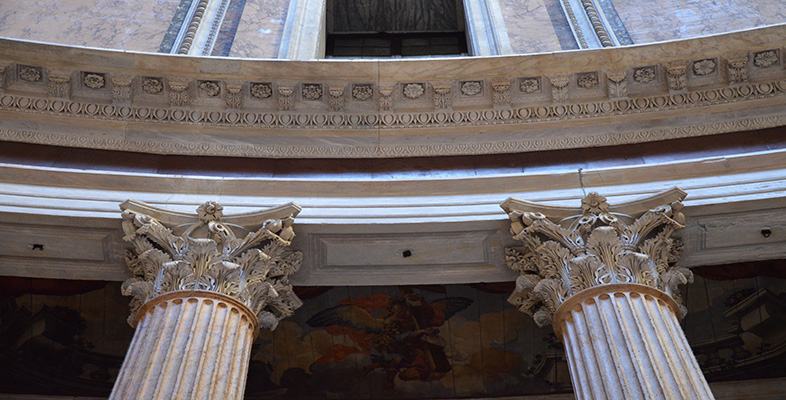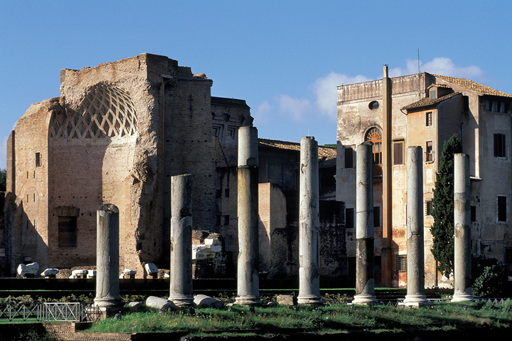2.2 The Temple of Venus and Rome
In this section we’ll consider another of Hadrian’s building projects: the Temple of Venus and Rome.
Activity 6
Go to the interactive map [Tip: hold Ctrl and click a link to open it in a new tab. (Hide tip)] to locate the Temple of Venus and Rome and establish some basic facts about it:
- where was it located?
- what building was on the site before the temple?
- when was it dedicated? (Think about when this was in the context of the periods when Hadrian was in Rome rather than travelling around the empire.)
- which emperor restored the temple?
Discussion
The temple was located between the Roman Forum and the Colosseum valley, so its construction enabled Hadrian to put his mark on this central public area of the city. It was what Hadrian built instead of another Imperial Forum, and it was his most significant building project in the Forum area. With the Temple of Deified Trajan he had sealed off the Imperial Fora, which had no further space for expansion in any case, as they were by then abutting the Campus Martius. So, Hadrian built at the opposite end of the Forum Romanum, in an area previously dominated by Nero’s Domus Aurea. The Colossus of Nero (which gave the Flavian amphitheatre its nickname) had to be moved to make way for a huge artificial platform (145 by 100 metres). The highly visible Greek-style temple was built on top of this.
Building took time. The temple was dedicated by Hadrian on 21 April 121 CE, one of the few occasions when he was in Rome, but was not completed until at least 135 CE. It may not have been completed by Hadrian at all, but by his successor, Antoninus Pius.
The visible remains of the temple date to a later phase. It was rebuilt by Maxentius after a fire in 307 CE, so it is difficult to visualise the Hadrianic structure, especially as the coffered concrete vaults remind us of the domes for which Hadrian was famous, but actually belong to the restoration.
Activity 7
Read the following two sources, and then answer the questions below:
Primary Source 1: SHA, Hadrian 19: from ‘With the help of the architect …’ to ‘… the architect Apollodorus’.
Primary Source 2: Dio Cassius: 69.4.
- What evidence do we have that Hadrian was the architect of the Temple of Venus and Rome?
- What criticisms did Apollodorus make of his design?
- What does this tell us about the way later authors, such as Dio Cassius, perceived Hadrian’s relationship with his peers?
Discussion
The SHA describes how Hadrian oversaw the moving of Nero’s Colossus and, having rededicated the statue to the sun, Helios, commissioned Apollodorus to design a second statue to represent the moon. This suggests that the temple was Hadrian’s project, but there is no direct evidence that he was the architect. Instead, we read that he employed at least two other architects to realise the project.
If Dio Cassius can be believed, Hadrian and Apollodorus were competitive and keen to criticise each other’s ability as architects, and their artistic differences ultimately led to Apollodorus’ death. That this anecdote is reported by Dio Cassius reveals how hostile the senatorial classes remained to Hadrian after his death. However, there may be a grain of truth in the story: the reported quote ‘draw your gourds’ may refer to the complicated concrete domed structures Hadrian was sketching as part of his designs for the villa at Tivoli, and perhaps also refers to the design of the Pantheon, which was completed around the time that work began on the Temple of Venus and Rome. Apollodorus’ specific criticisms of the plans for the temple were that it was not elevated enough and the cult statues were out of proportion with the cella.
It is also possible that Apollodorus criticised Hadrian’s temple design because it was Greek in style (and one might expect a temple to the goddess Roma to be Roman in style). It sat on a low podium, with a few steps, and was surrounded on all sides by a colonnade, all of which are Greek features. You may remember that Hadrian’s love of Greece and Greek culture, his philhellenism, won him the nickname graeculus: ‘little Greek’ (SHA, Hadrian 1.5). The temple actually comprised two Roman-style temples placed back-to-back – one dedicated to Venus, the other to Roma – and this is what created the overall effect of a Greek temple.
The temple design therefore represented the emperor’s love of both Greece and Rome, but what was the significance of Hadrian dedicating a temple to Venus and Rome?
His choice of deities linked Hadrian to Augustus, the Julian gens (clan) and their ancestral deity, Venus, as well as to the city itself, in the guise of the goddess Roma. Although Roma features on one of the relief panels of the Augustan Ara Pacis, and had been personified as a goddess in the eastern Mediterranean for some time, the temple was the first to be dedicated to Roma in Rome itself. For a peripatetic emperor like Hadrian, this commemoration and personification of Rome may have been an attempt to show the Senate and the Roman people that he was devoted to the capital city, despite his frequent absences from it.
Hadrian dedicated the temple on 21 April, the date of the Parilia festival, on which (according to Roman tradition) in 753 BCE Romulus had founded the city of Rome. Having dedicated the temple, Hadrian renamed the festival the Romaia. In so doing, he revitalised the festival which celebrated Rome’s origins and the common identity of the Roman people. Coins proclaimed a new Golden Age (saeculum aureum), making Hadrian the new Romulus. Augustus had done something similar (and had almost taken the name Romulus).
By dedicating the temple to the goddess Roma, Hadrian demonstrated his devotion to the city and emphasised the power of Rome within a vast empire. The temple’s design reflected the personal interest he took in the empire as a whole, and this would particularly have been the case if Hadrian were the architect of the temple. The Temple of Venus and Rome therefore reinforced and celebrated the traditions and past of Rome, but also made a visual reference to the wider empire which would have been recognised by Rome’s inhabitants and visitors to the city.
Activity 8
To complete your study of the Temple of Venus and Rome, turn to Reading 1. This is a section from Mary Boatwright’s book Hadrian and the City of Rome. Read from the start to ‘… probably of peperino’ (p. 128), and then answer these questions:
- What evidence (written and material) does Boatwright use to discuss the Temple of Venus and Rome?
- How does Boatwright use the archaeological evidence to construct her interpretation of the temple?
- How convinced are you by her analysis?
Discussion
- Boatwright draws on a range of archaeological evidence to construct her argument: the architectural remains of the temple (complicated by the restoration by Maxentius), coins and brick stamps. She is dismissive of Dio Cassius’ anecdote about Hadrian and Apollodorus and therefore relies almost entirely on archaeological evidence. She also uses secondary sources, drawing on earlier publications to provide information about aspects of the temple which were recorded in the nineteenth and early twentieth centuries, but have since been lost.
- Boatwright begins by establishing the dates of the temple’s construction, using a combination of different types of evidence: the comparatively rare brick stamps, coins and literature. When she studies the architecture, the first thing Boatwright does is to identify surviving Hadrianic elements in the Maxentian restoration of the temple. With this architectural foundation she is able to construct an interpretation of the Greek and Roman elements (which include aspects of architectural style, materials and decoration).
- How convincing you find Boatwright’s argument will be quite personal, but do pay close attention to the way she weaves together the different sources of evidence. A significant part of her argument is that the temple was completed by Hadrian’s successor, Antoninus Pius. How does this compare with the argument made by Mark Wilson Jones in the audio recording ‘The Pantheon’ that the Pantheon was begun by Trajan and completed by Hadrian? Note that both scholars use brick stamps as evidence for their interpretation of the chronology of the buildings. This is in part because both of them consider these to be more reliable evidence than the written sources.

